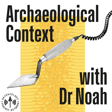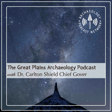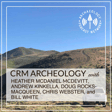Become a Creator today!Start creating today - Share your story with the world!
Start for free
00:00:00
00:00:01

Flowers on graves - Funerary practices since the Neanderthals? - With Dr Emma Pomeroy (S01E01)
Welcome to 23 minutes archaeology with Noah! For episode 1 I will give a general introduction concerning the limitations of archaeological research, especially in the reconstruction of burial rites. I chose an example to illustrate how we work and try to find clues on prehistoric funerary practices. We will look at over 50-thousand-year-old, intentional burials of Neanderthal-individuals, found in Shanidar Cave and talk with Dr. Emma Pomeroy from the University of Cambridge, who published the amazing new results from the recent excavations of this northern Iraqi site.
Reverences:
- Pomeroy et al. (2020), New Neanderthal remains associated with the ‘flower burial’ at Shanidar Cave
- Pomeroy et al. (2019), Issues of theory and method in the analysis of Paleolithic mortuary behavior: A view from Shanidar Cave
- Sommer (1999), The Shanidar IV ‘Flower Burial’: A Re-evaluation of Neanderthal Burial Ritual
- Leroi-Gourhan (1998), Shanidar et ses Fleurs
- Solecki (1975), Shanidar IV, a Neanderthal Flower Burial in Northern Iraq
Support via patreon.com/23minarch
Transcript
Introduction to '23-Minute Archaeology'
00:00:09
Speaker
Flowers on graves, funerary practices since the Neanderthals. Yes, the world needs another podcast. Hello everybody and welcome to the very first episode of 23-Minute Archaeology with me, Noah.
Podcast Format and Social Media
00:00:25
Speaker
Since this is our first time together, let me quickly give you a layout of the whole thing. My aim is to show and highlight amazing archaeological finds from our past, from around the world and in a way that is accessible to everybody. So, we'll be discussing themes like mummies from glaciers, Siberian graves with treasures of gold or the diet of Celtic warriors.
00:00:49
Speaker
The idea is that for around 15 minutes I'll give you an introduction and overview of the topic and then, for the remaining time, we will talk with an expert currently researching the specific topic. As archaeology is quite a visual discipline, this podcast also has an Instagram page. So, for better understanding, I will upload a few pictures each episode of whatever we're discussing.
00:01:14
Speaker
So, while listening, you can actually go and see mass graves from the Stone Age or tattoos on mummies and so on. My aim is for this to be fun and informative for everybody, but still with the premise of being scientifically accurate.
Noah's Background and Research
00:01:30
Speaker
That's why you'll find references of the articles and books I used in the description of each episode.
00:01:36
Speaker
At last, quickly to myself, as I said, my name is Noah, I'm from Switzerland and I studied prehistoric archaeology. Currently, I'm working on my PhD thesis. Okay, now that that's out of the way, let's start with episode 1.
Neanderthal Burials: Shanidar Cave
00:01:53
Speaker
Considering our upcoming episodes, I thought it would be good to first give a general introduction concerning the limitations of archaeological research, especially in the reconstruction of burial rites. I chose an example to illustrate how we work and try to find clues on prehistoric funerary practices.
00:02:12
Speaker
We will look at over 50,000-year-old intentional burials of Neanderthal individuals found in Shanidar Cave and talk with Dr. Emma Pomeroy from the University of Cambridge who published the amazing new results from her excavations of this northern Iraqi site.
00:02:51
Speaker
Mortuary behavior is one of the many traits that were previously widely considered to be uniquely human. It can be broadly defined as any activity that involves the dead body of a conspecific and may include various types of ritualized or symbolic components.
00:03:10
Speaker
Examples of morture behaviour have been documented for a variety of species, from the carrying of dead infants by chimpanzee or gorilla mothers for weeks at a time, or the revisit of elephant carcasses by members of their social group.
00:03:28
Speaker
What most of these burial practices have in common is that they occur in species with a relatively high level of social cognition with long-term bonds between group members. So, while some researchers have debated whether Neanderthals practiced certain mortuary or burial behaviors, very few have argued that they lacked the capacity of such.
00:03:54
Speaker
Thus, there is no reason to expect no burial activity among Neanderthals, we just need to find them. But how do we do it? In general, archaeological research tries to reconstruct human actions based on findings in the ground.
Interpreting Archaeological Artifacts
00:04:12
Speaker
The repeated observation of the same archaeological findings allows to characterize a practice. This practice itself can correspond to a rite if combined with ritual ideas, which in turn are very likely in the context of burials of human remains. A wide variety of cults and rituals can be expected for the funerary habits in prehistoric times.
00:04:37
Speaker
So, with the data from the analysis of human remains and objects, we try to find clues of these burial rites. But it's important to keep in mind that the spiritual world, the belief system and quote-unquote religion, etc., remains hidden for the most part. Archaeology is only able to grasp the materialization of such rites, which we then try to interpret.
00:05:04
Speaker
for example by analogies from ethnological accounts. The aspect of the quote-unquote sacred in an object or action is often not recognizable as such. Only objects that deviate strongly from the norm are often assigned in the area of cults or rituals.
00:05:23
Speaker
It can be assumed that many more objects had a symbolic or religious meaning than we can recognize today. In other words, the beliefs of the prehistoric people remain hidden from us for the most part.
00:05:38
Speaker
In addition, the burial which we excavate corresponds probably only to one aspect of a longer and more complex funerary process, from the determination of death to the actual burial. It is likely that many stages of this process leave no archaeological traces at all,
00:05:59
Speaker
for example the preparation and decoration of the corpse or honors and lamentations, and may have been more important in the burial ritual than the actual burial itself. It is also important to keep in mind that with discovered graves we also only have a section of the whole prehistoric population.
00:06:22
Speaker
Many more graves may have not been found yet were destroyed or the people were buried in a manner which leaves almost no traces. Archaeology can therefore only get a very incomplete picture of the past.
00:06:37
Speaker
it is consequently difficult to interpret and even recognize certain burial practices on the basis of archaeological evidence and to understand the attitude of prehistoric people towards death without relying too much on pure speculation, which I generally try to avoid.
00:06:58
Speaker
One of the challenges encountered in the discussion of mortuary behavior in Paleolithic times is terminology, since the label as quote-unquote grave can evoke the image of a deep linear ditch, which is not the case with respects to Neanderthal burials.
Neanderthal Burial Practices
00:07:18
Speaker
In the Paleolithic period, excavation tools were very rudimentary, so burial pits were probably not very deep or regular. It is likely that available natural sites such as caves were favored by Neanderthals to dispose of their dead. Bodies may have also been deliberately covered with soil, for example, to deter scavengers.
00:07:45
Speaker
With all these restrictions and limitations in mind, let's now look at a specific example. In this episode we will discuss the Neanderthal burials in Shanidar cave, famous for quote-unquote presumed deliberate deposition of flowers on burial number four. I will not go too much into detail into this very interesting site here, but I think it serves as a good example of how archaeological research works.
00:08:13
Speaker
Shanidar Cave is located in northern Iraq and was excavated between 1953 and 1960. Initially, the remains of nine Neanderthals were found, indicating that the Neanderthals repeatedly returned to the same spot to bury their dead.
00:08:31
Speaker
Neanderthals probably also used the cave for shelter and as a temporary resting place, indicated by traces of fireplaces containing animal bones and burned plant remains. It was suggested that some of the discovered individuals may have been killed by rocks falling from the cave roof, while others had been buried with former burial rites.
00:08:55
Speaker
The latter mainly includes Shanidar IV, the so-called flower burial, because clumps of flower pollen were found in two soil samples surrounding the human remains of burial IV. They were interpreted as evidence for the intentional placement of flowers with the buried individual.
00:09:17
Speaker
And of course, it's fascinating and evokes a lot of images to think of grieving Neanderthals placing flowers on graves of loved ones, just like we do but over 50,000 years ago.
00:09:32
Speaker
However, this so-called flower burial remains controversial. Some have argued that wind could have brought the pollen into the cave. Jeffrey Summer suggested in an article in 1999 that a small rodent, Meriones persicus, could have also been capable to bring enough flower heads into the cave to account for the pollen found near Burial IV.
00:09:58
Speaker
because during the excavation it was obvious that the cave floor was full of rodent burrows and it's not clear if they were avoided during soil sampling. These rodents store large amounts of seeds and other vegetable material reportedly entire flower heads in their burrows and many bones of these rodents were found in the cave and they could be responsible for the flower pollen found under grave 4.
00:10:30
Speaker
A new research program led by Professor Graham Barker from the University of Cambridge between 2015 and 2020 revealed several new Neanderthal bones in the Shanidar cave. These in situ Neanderthal remains provide strong evidence for the deliberate burial of individuals.
00:10:50
Speaker
In situ is another term I will probably repeatedly use in this podcast. It's what archaeologists call finds that are still, more or less, in their original place and haven't been moved.
00:11:04
Speaker
In 2017 they found the upper body of an individual named Shanidhar Z. The surrounding layer contained charcoal, lithics and animal bone splinters. One piece of flint with useware signs was found near the back of the individual. Maybe it can be regarded as a grave good.
00:11:25
Speaker
The individual itself was almost in sleeping position, laid on the back, with the head resting on top of the left hand. A stone was placed behind the head. The articulated nature and completeness of the remains indicates a deliberate placement and burial of the body, otherwise it would have been exposed and accessible to scavengers.
00:11:50
Speaker
The preliminary results of the recent dating programme indicate that Neanderthals repeatedly placed bodies in the Shanidar cave over a period of at least 20.000 years, from around 70.000 to about 50.000 years ago.
00:12:07
Speaker
Over this long period of time, it is very unlikely that there was a consistent quote-unquote burial tradition. It's also important to note that Neanderthals shouldn't be considered as a single entity. Over a period of some 300,000 years, their range expanded from Spain to Siberia.
00:12:28
Speaker
They showed different regional, cultural and technological developments, for example, in the type of stone tools they used. It is therefore extremely unlikely that their burial behavior was uniform.
00:12:43
Speaker
So, with the example from the Neanderthals, I hope I was able to give you some basic aspects of how archaeologists try to find out more about prehistoric funerary habits and how difficult it is to actually find clear evidence for certain rituals without relying too much on speculation.
Interview with Dr. Emma Pomeroy
00:13:05
Speaker
And with that, I am very happy to present to you my conversation with Dr. Emma Pomeroy about her research project.
00:13:23
Speaker
Emma, first, thank you very much for taking the time to talk with me. And maybe as a starter, in my opinion, one of the interesting aspects about our profession is to be able to do field research and go on excavations in remote and distant places. As Shani Dar Cave is located in northern Iraq,
00:13:43
Speaker
What were your experiences working there, maybe also in regards to cooperation with local authorities? I'm asking, since your research project went on during the last five years, the time we were all disturbed by the activities of ISIS, I'm thinking of the destruction of Palmyra in Syria, for example, in 2015. So what were your experiences in that regard?
00:14:09
Speaker
Yeah, no, I mean, I would agree. It's one of the real privileges of our field is that we can sometimes get to go and work abroad, but sometimes these very challenging places to work to. The project itself at Shenandoah Cave was actually set up initially at the invitation of the general director of antiquities in Iraqi Kurdistan.
00:14:30
Speaker
They approached Professor Graham Barker at the University of Cambridge. From the very beginning, there was quite a close working relationship with the local authorities. Not only with the General Director of Antiquities, but also the local office at Soran.
00:14:45
Speaker
which is the one that covers the particular area of Shandar Cave. And yes, I think they first approached Graham in 2011, and then excavations first were starting in, I think, around 2014. And that's before I joined the project, because I'm a paleoanthropologist and osteoarchaeologist, and the intention was actually never to really find any more Neanderthal remains. And so I joined once they did.
00:15:14
Speaker
But in that first field season, unfortunately, they did have to evacuate because ISIS were threatening the airport to Erbil, which is where we travel into, and it's relatively close to the site. Since that, though, touch wood, we've been fairly lucky in terms of being able to carry on with fieldwork undisturbed. There's very good security in that region.
00:15:44
Speaker
it feels you know there's road checks and things like that so so we feel pretty secure and it's actually really wonderful because there's I think it's hard to imagine what life is like in other parts of the world where they are really troubled by some of these sort of political situations that we don't experience firsthand.
00:16:03
Speaker
And so it's really reassuring working at the cave that actually on a Friday, which is sort of the day off there, we get loads of local visitors. There's lots of people coming and having picnics at the site and coming to see it. It's a very important cultural site, but it also speaks to the fact that there is a great deal of normal life. And that's a good thing to see going on.
00:16:26
Speaker
Okay, that's very nice to hear. I touched upon, to get to the specific side, I touched upon the debate about the so-called flower burial, burial number four. Where do you land on this? Is the pollen from a rodent? Did wind blow it into the cave or was it placed there intentionally by, quote-unquote, grieving Neanderthals?
00:16:50
Speaker
That's a really good question, and I think it's still unresolved. I mean, I think before I joined the Shenandoah Cave Project, I was pretty skeptical that it was a genuine flower burial, as Ralph Selecke had put it across, and that probably it was either contamination or you mentioned rodents or wind blowing it in, or even the workmen kind of bring it in on their clothes, that kind of thing.
00:17:13
Speaker
I think certainly with the more recent findings we've had with Shenandoah Z, which is the new Neanderthal remains that we found more recently that are directly associated with that Shenandoah 4 cluster, we have direct evidence for preservation of plant materials at least.
00:17:33
Speaker
And we don't see a great deal of evidence in that particular area for rodent burrows, although there are insect burrows, so that might be another explanation. But certainly there's preservation of ancient plant materials which would suggest that they're not necessarily modern contamination.
00:17:52
Speaker
It's also very interesting. We've been working with Ralph Selecke's archive at the Smithsonian Institution in the States. And there's some very interesting correspondence there from Arlette Leroy-Gorran, who was the paleontologist who did that original work, with Ralph Selecke, who was the original excavator. And she makes some really interesting points about
00:18:16
Speaker
how some of these explanations are unlikely and things like rodents, she said the kind of flowers actually they would struggle to get hold of them because they're on big long stems. So it seems very unlikely that they would then climb up these stems and pick the flowers and drag them down into burrows and things like that.
00:18:31
Speaker
and there's various reasons she outlines that those explanations don't really work so that for me is also quite convincing and I think that's one of the exciting things with our recent findings that we've kind of got another opportunity to actually
00:18:49
Speaker
sort of look at whether there's pollen and other plant remains in that particular area. I think it's also telling that there were the clusters of pollen and as Arletli Roygoran describes in the original publication, you know, there were clusters of pollen and they did actually sample elsewhere in the cave, perhaps not as systematically as we would do today, but the pattern around Chaldar 5 was different.
00:19:18
Speaker
The matter of interpretation is a tricky one because then is it sort of grieving the Neanderthals, putting flowers there in a way that we would really recognise in kind of recent Western culture?
Shanidar Cave: Neanderthals and Modern Humans
00:19:29
Speaker
Or is it something else? And we're considering other potential explanations. For example, it could be that the body was covered with some of these plants rather than it being sort of covered with soil, for example.
00:19:42
Speaker
and that might be an explanation. There are some of the plants as well are not the ones that you might necessarily lie or think to lie kind of a close relative or someone you feel you know a lot of compassion for on top of because they're kind of spiky and not
00:20:01
Speaker
necessarily the things that you might associate with putting with the body. I think we have to entertain other explanations and perhaps this is like a covering or something like that potentially. More work to do, but I certainly think now that the flower barrel is a possibility and it is great to have this opportunity to re-investigate some of the different theories that are out there and perhaps rethink the evidence.
00:20:30
Speaker
Yeah, of course. And it just evokes also a lot of images thinking about this practice. Yeah, absolutely. The human remains of at least four individuals were found clustered together. And maybe it's important to state that it's quite a big cave, at least as far as I understood. That was probably repeatedly visited over a very long timeframe of up to 20,000 years. Why do you think were they clustered?
00:20:58
Speaker
do the remains represent a collective burial or was the spot marked or special in some way? That's a great question and again we're still sort of thinking through the different explanations for this because you're absolutely right. I mean those four individuals and one of which was the flower burial of Shenandoah 4 were found within sort of a meter by a meter by half a meter
00:21:23
Speaker
block of sediment. So they're really tightly together there. And the new remains that we found, Shandar Z, are probably part of that same four individuals. So it is very tight and it is a big cave. So you then do question, well, why four individuals in such a small space?
00:21:41
Speaker
It could be that they died at the same time, and unfortunately, that evidence was lost with that original block of sediment they took out with Shenandoah 4 and the other individuals of the cluster, because they then had to transport that block. This was 1960, they had to transport it then down to Baghdad. It was excavated in the museum there, but by the time it got there, the remains had become rather jumbled, so they couldn't see the relationships.
00:22:07
Speaker
and see whether these individuals were likely to have been there at the same time or whether there's actually sediment between them, things like that.
00:22:19
Speaker
one of the things that we have with the new remains, so we do have the Shenandoah Z remains, but beneath that there are some sporadic other remains that are separated by a good layer of sediment, a good few centimeters, and that suggests to me at the moment, although there's more work to do, that perhaps there is a gap in time and they are coming back to this one same spot.
00:22:44
Speaker
why they're doing that and how they're doing that is obviously another big question and it would seem so next to where the flower barrel was removed and where Shenandoah Z is we have this sort of vertical block of stone that has fallen from a big fault line in the roof of the cave and that was there before the bodies were there so that would suggest that this could have acted as some kind of a marker for that one particular spot
00:23:11
Speaker
So I think although we're still looking at this, there is some evidence of returning to that same spot on different occasions from the new evidence we have. I think possibly we're never going to be able to answer that definitively for the Shenandoah 4 cluster because, like I said, that evidence was just not preserved in that case.
00:23:32
Speaker
But I think we can say, yes, they were coming back to the same spot, placing remains in that same spot. And there is the possibility of the marker there. And then we need to think quite carefully about how we might interpret that in terms of being a special place or a convenient place and investigate the evidence potentially for other markers. We did find an unusually placed stone with
00:23:58
Speaker
Shanadar Z, sort of behind the head, which again might suggest another marker. But we also have to entertain more kind of straightforward explanations as well. So yeah, I guess the important thing is not to jump to conclusions and actually evaluate and let the evidence speak for itself.
00:24:19
Speaker
Yeah, yeah. And I'm not an expert in the geographic region or the subject, but during the timeframe of the Neanderthals visiting the cave and its surroundings, do you also have traces of other Homo sapiens? Were they present at the time or location?
00:24:40
Speaker
Yeah, so that's actually one of the questions we're trying to sort of unravel a bit further in the Shandar Cave project at the moment. So we knew from, for example, at Shandar Cave from Seleki's excavations there, that there was a
00:24:56
Speaker
that the modern humans did follow the Neanderthals there. And Silecki suggested there was a substantial gap of perhaps thousands of years. And the initial kind of upper Paleolithic in the region is called the Barodostian. And we do get these Barodostian tools in the layers above the Meisterian and Neanderthal remains below. We don't have any modern human remains until much later. So those sort of
00:25:24
Speaker
it's hard to, you know, although we've got the Neanderthal remains, we don't have very early sort of paleolithic modern human remains. One of the things that we're observing as we sort of revisit the areas that Silecki excavated was actually that there wasn't such a big gap and that there may have been
00:25:43
Speaker
potentially some overlap or certainly a close following of modern humans to Neanderthals in the cave. But it's something that's quite complex to unravel, like a lot of caves, the geology and the sediments. Cave stratigraphy is notoriously tricky to interpret. That's something we're still working on. Another technique we're trying as well is, as they've tried other sites, environmental DNA, so extracting DNA from the sediments.
00:26:12
Speaker
It's tricky somewhere like Shenandoah because you've got a very warm environment, so it's not great for the preservation of DNA. Up until now, we still don't have Neanderthal DNA or early modern human DNA from that far south because of preservation issues. We are trying this environmental DNA technique as well because that might also give us an indication of actually who's in the cave and who is responsible for
00:26:37
Speaker
producing particular stone tools and whether there may have been any overlap. So yes, it's something that we're working on and hopefully in the next few years we'll have some greater clarity.
00:26:51
Speaker
Yeah, yeah. And also, coming back to funerary practices, I found it very interesting to read about the evidence of compassion, as you named it in one of your publications, with the Neanderthal individuals from Shanidar Cave, with evidence of bone fractures and partially paralyzed individuals that probably had to be cared for by members of their social group.
00:27:17
Speaker
But also of violence with a puncture wound, probably from a projectile of one rib from individual three. Am I understanding that correctly?
00:27:30
Speaker
Yes, no. From the Neanderthals that were originally excavated by Ralph Stilecki's team and analyzed by Eric Trinkhouse and T. Dale Stewart, we do have a range of evidence. As you say, Shenandoah 3 has evidence of a puncture wound in the ribs. Shenandoah 1 very famously had suffered a head injury which probably left him blind in one eye. He was partially deaf, partially paralyzed on one side and probably had his right arm amputated above the elbow.
00:27:59
Speaker
and yet survived a number of decades. So that does perhaps suggest
00:28:07
Speaker
what we might consider to be compassion. Again, we have to be a little bit careful with interpretation because our interpretations can be a bit clouded by our perception of ability and disability and whether that's correct to project those ideas onto the past. There's a very interesting sort of developing
00:28:32
Speaker
analysis and approaches in this respect of looking at the archaeology of disability and ability in the past and the bioarchaeology of care approaches that's been termed. But I do think probably this does suggest a degree of compassion and it's
00:29:00
Speaker
interesting some of the suggestions have been made how that also links to whether we can interpret the deposition, the intentional deposit of bodies, perhaps burials, if they were that, as another sign of compassion to fellow individuals. But of course, it's tricky because people
00:29:20
Speaker
might bury or dispose of the dead in different ways for many reasons and some of that might be emotional, some of that might be symbolic, some of that might be entirely practical. So we do have to weigh up the evidence carefully I think before jumping to big conclusions about how they necessarily felt or why they did things they do.
00:29:42
Speaker
And maybe speaking of that, I mostly work with Neolithic graves. But I ask myself the probably a bit philosophical question, when did humans develop an awareness of death? So of course, that's very difficult or even impossible to answer. But can you give us any insights with your experiences in Paleolithic grave archaeology? When do we see the first quote unquote intentional or proper burials?
Symbolism and Mortuary Practices
00:30:12
Speaker
Yeah, I mean, it's again a quite contentious issue that's still widely debated because as I just mentioned, there are many reasons why people or hominins might have
00:30:26
Speaker
done a particular thing with remains of other individuals and that could be really sort of mundane as to get rid of getting rid of a kind of stinky body from the area you're living in not to attract you know carnivores and things like that or it could be imbued with compassion. We can see
00:30:46
Speaker
if we go back, signs of at least treatment of the body. We can look, for example, at Sima de los Huertos, where we've got a number of individuals deposited into a cave from above down a shaft, something similar with Homo nulidi. How we interpret that is, again, the tricky thing, whether that is symbolic in the way that we would
00:31:14
Speaker
sort of treat our dead and how modern humans treat the dead. I mean, across societies, we see symbolic treatment of the dead. Whether we can infer that for these early examples, you know, Simo de los Hueso, so potentially sort of 450,000 years ago, again, we have to be a little careful. And the examples are, you know, relatively few and far between. These are kind of exceptions from what we know at the moment.
00:31:42
Speaker
the whole issue of burial is an interesting one as well because I think sometimes the whole idea of burial itself is sort of over, is given too much importance. What is really important is the symbolic treatment of the dead. You know in the west we, burial is one of the big ways that we
00:32:05
Speaker
lay our dead to rest and so to us it seems to be important but actually if you look cross-culturally in modern human societies people treat the daily in all sorts of ways and you know we see sky burials and cremation and water burials you know all sorts so I think sometimes we give too much emphasis to burial per se and what we should actually be looking for is more kind of mortuary treatment so
00:32:34
Speaker
Perhaps, for example, so coming back to the Shenandoah Zed example, it might be that that individual was buried. As in, they were put into a cut grave and then covered over with soil. But it could actually be, and we're investigating this, they were put into this excavated dip into a shallow scoop.
00:32:56
Speaker
and covered with something else like branches or skins or something like that and so then technically that's not necessarily burial because you're not covering in soil yeah yeah it does not matter because if that is some kind of intentional and symbolic treatment of the body that's still something telling us something very important about how people thought about cognition about attitudes so so yeah i kind of prefer to look more broadly it kind of
00:33:25
Speaker
what we might call mortuary treatment and evidence for symbolic treatment of the dead in a variety of ways. Certainly we see signs of that, as I said, going back some time, hundreds of thousands of years in the hominin lineage.
00:33:45
Speaker
I think we see it more consistently when we have Neanderthals and then anatomically modern humans as well. But like I said, the whole issue of interpretation and then whether we see that in very kind of mundane terms or whether we can see or interpret that aspect of kind of symbolism and emotion is a much trickier question.
00:34:12
Speaker
Yes, of course. And also with the variety of funerary practices also in the Neolithic graves, I mean, you also have probably only a small fraction of all the population that was alive and died then. Yes. Absolutely. And then you have to be a bit careful about sort of extrapolating those
00:34:32
Speaker
interpretations as you know to the whole society but actually maybe you've got a kind of an unusual exceptional small part of that particular society. Yes exactly, exactly. So yes thank you so much for having this this conversation and I'm looking forward to reading about your your future research about this very interesting topic. Thank you so much. No thank you very much it's great to chat.
Conclusion and Call to Action
00:35:05
Speaker
Okay, that was it for the first episode of 23-Minute Archaeology with me, Noah. I hope you enjoyed it and maybe even learned something new. Again, you can go on Instagram and look at some pictures of these Neanderthal graves. And if you want to keep the podcast going, I would be very grateful for your support over on Patreon.
00:35:27
Speaker
With that, I want to thank Dr. Emma Pomeroy again for the very interesting conversation and my friends from the band Crying Vessel for the music. I hope you will tune in again for episode 2, where we will talk about what Herodotus had to say about Scythians in the Eurasian Steppe.





